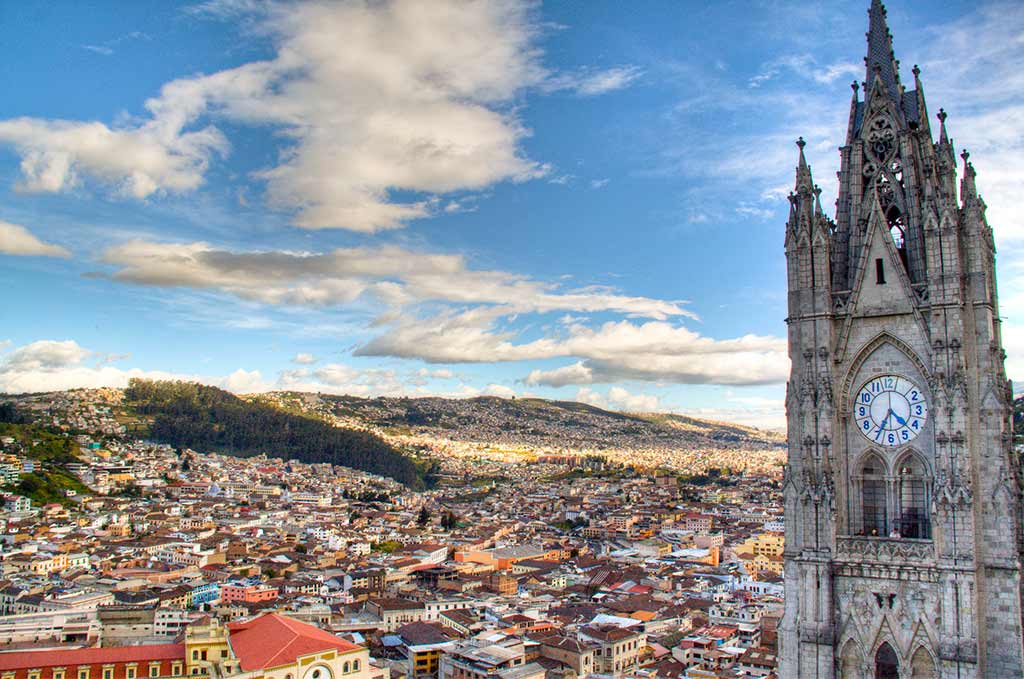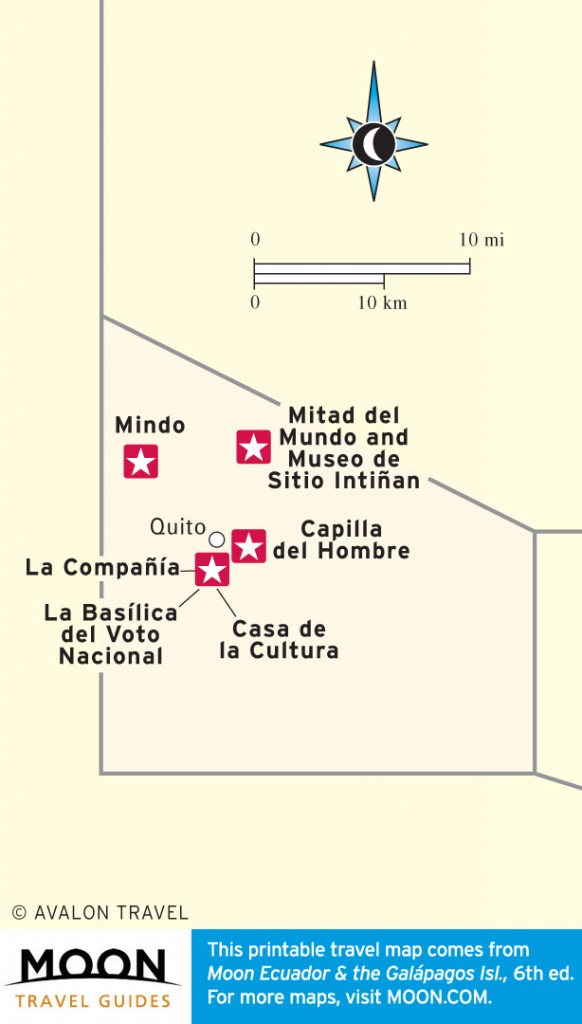Ecuador’s capital is a city that scales many heights, not least in terms of elevation. The second-highest capital in the world after Bolivia’s La Paz, Quito sits at 2,850 meters above sea level in a valley hemmed in by mountains, including the twin peaks of Volcán Pichincha. Quito’s dramatic geographical position has led to its long thin shape: spread out over 50 kilometers long, but just eight kilometers wide.
Quito (pop. 1.6 million) is an intriguing mix of old and new: colonial squares and concrete office blocks, traditional markets and modern malls, indigenous artisans and fashion-conscious professionals—and this diversity allows visitors to have the best of both worlds. The centro histórico (historic center) delivers a delightful trip back in time to the colonial era with narrow cobbled streets, elegant plazas, and spectacular churches. New Town, on the other hand, looks firmly forward and is so cosmopolitan that parts of it are nicknamed gringolandia. With a vibrant cultural scene, great nightlife, a vast array of hotels, travel agencies, and the country’s best range of restaurants, it’s no surprise that Ecuador’s political capital is also its tourism hub.

Quito, Ecuador
Much of the population of Ecuador’s second-largest city lives in barrios (neighborhoods) or shantytowns, either up the slopes of the mountains or spread north and south of the city center. The people themselves are historically more conservative than in the rest of Ecuador; the capital has always clung to traditional, conservative values, in contrast to the outward-looking merchants of Guayaquil. However, a new generation, a large student population, and modern businesses have all injected a healthy dose of open-mindedness. Most importantly, visitors will find Quiteños helpful, welcoming, and justifiably proud of their city.
Quito’s residents have plenty to be proud of: In 1978 it was the first city in the world to receive World Heritage Site status from UNESCO. Although there have been problems with upkeep, in recent years a multimillion-dollar regeneration program has left the city in better shape than ever. A new feeling of cleanliness and security pervades Old Town, with an increased police presence and a burgeoning cultural and nightlife scene. Interior patios have been tastefully renovated, and street artists have replaced beggars and hawkers. New Town is also increasingly well kept, although it has some way to go to solve its security problems.
According to a pre-Inca legend, the city of Quito was founded by Quitumbe, son of the god Quitu, in honor of his father. The valley that would eventually cradle Ecuador’s capital was originally occupied by the Quitu people, who united with the Cara from the north to form the Shyris nation around AD 1300. In 1487 the Incas took over and turned the city into an important nexus of their northern empire, known as the Quitosuyo. Within 100 years the empire fell to infighting, leaving room for the newly arrived Spanish to start almost from scratch.
The city of San Francisco de Quito was founded by Sebastián de Benalcázar on December 6, 1534, and named in honor of fellow conquistador Francisco Pizarro. Benalcázar quickly set about appointing government officials, distributing land to his men, and constructing churches. Originally, Quito consisted only of the present-day section known as Old Town, bounded by the Plaza de San Blas to the north, the Pichinchas to the west, and the Machangara ravine to the east. An art school was founded in 1535 and helped the city become a center of religious art during the colonial period, with its own style, the Quito School.
Since its founding, Quito has been an administrative rather than a manufacturing center. A population boom in the mid-20th century, aided by the discovery of oil, brought thousands of immigrants who spread their homes and businesses into today’s New Town, as well as farther south of Old Town and west up the slopes of Pichincha. By the mid-1980s, these makeshift suburbios housed as much as 15 percent of the city’s population and had acquired most of the services that the older areas took for granted. An earthquake in 1987 damaged numerous structures and left others in ruins, and the eruption of Guagua Pichincha in 1999 showered Quito in ash but otherwise left the city unscathed. Today, the city is officially home to about 1.6 million residents, but the real number is likely higher.
![Old Town Quito, Ecuador. Photo © Albert Backer (Own work) [<a href="http://creativecommons.org/licenses/by-sa/3.0">CC BY-SA 3.0</a>], <a href="https://commons.wikimedia.org/wiki/File%3AQuito-Historic-Town.jpg">via Wikimedia Commons</a>](https://www.holidaytravel.cc/Article/UploadFiles/201602/2016021615085885.jpg)
Old Town Quito, Ecuador. Photo © Albert Backer (Own work) [CC BY-SA 3.0], via Wikimedia Commons.
Quito is famed for its springlike climate, and most of the year daytime temperatures fluctuate 10-21°C. Mornings tend to be chilly, but it can heat up considerably around midday, and temperatures drop quickly on rainy afternoons and in the evenings. Locals say that the city can experience all four seasons in a single day, and that isn’t far off the mark. The dry season lasts June-September, with July-August seeing the least precipitation. This is also the warmest time of year. A shortened dry season runs December-January, which is also the coldest time of year. The most rain falls February-April and, to a lesser extent, October-November. Afternoons tend to be rainier, so sightseeing early is a good idea.
More of a consideration than the weather is the elevation, which will leave you breathless and light-headed for a couple of days. Dizzy spells, headaches, and fatigue can also occur. It is best not to overexert yourself and to minimize caffeine and alcohol in favor of plenty of water and light food. After two or three days, you’ll be used to the elevation.
La Compañía: The epitome of gaudy golden grandeur, this extravagant chapel is the most dazzling of all Quito’s many beautiful colonial churches.
La Basílica del Voto Nacional: The tallest church in Ecuador with its armadillo gargoyles is a striking sight, and even more spectacular are the views from its spires over Old Town.
Casa de la Cultura: From Valdivia figurines to giant bahía statues and a majestic Inca sun mask, this is easily Ecuador’s best museum.
Capilla del Hombre: Oswaldo Guayasamín’s final work, the Chapel of Man, is an awe-inspiring and humbling tribute to the indigenous peoples of the Americas.
Mitad del Mundo and Museo de Sitio Intiñan: Take the obligatory photo with a foot in each hemisphere (supposedly), then test out the real Equator a few hundred meters away at nearby Museo de Sitio Intiñan.
Mindo: This sleepy town, nestled in the cloud forest, teems with toucans, hummingbirds, quetzals, and butterflies. Adrenaline seekers can fly across the forest canopy on zip-lines or plunge down the river rapids.

Map of Quito sights.
Excerpted from the Sixth Edition of Moon Ecuador & the Galapagos Islands.